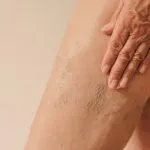Advertisement
This ad is displayed using third party content and we do not control its accessibility features.
Why A Lack Of Protein May Lead To Crepey Skin, From A Derm

Beauty & Health Editor
Beauty & Health Editor
Hannah Frye is the Beauty & Health Editor at mindbodygreen. She has a B.S. in journalism and a minor in women’s, gender, and queer studies from California Polytechnic State University, San Luis Obispo. Hannah has written across lifestyle sections including beauty, women’s health, mental health, sustainability, social media trends, and more. She previously worked for Almost 30, a top-rated health and wellness podcast. In her current role, Hannah reports on the latest beauty trends and innovations, women’s health research, brain health news, and plenty more.

Image by Leandro Crespi / Stocksy
August 08, 2024
We carefully vet all products and services featured on mindbodygreen using our
Our selections are never influenced by the commissions earned from our links.
Loose and sagging skin is a natural part of aging (which, as a gentle reminder, is a privilege in itself). However, the mechanism that leads to skin sagging can be directly influenced by the foods you consume and which ones you neglect.
Of course, consuming enough vitamin C and drinking loads of water is essential for bright and supple skin, but derms recommend prioritizing another food group as well if you want tighter, younger-looking skin.
Why you should prioritize protein to ease crepey skin
The underrated skin-loving food group in question? Protein. “A sufficient amount of protein as part of a healthy diet is essential to support the body’s ability to synthesize proteins of all types, including those in the skin,” board-certified dermatologist Hadley King, M.D., tells mbg.
There’s a plethora of proteins in your skin, the most abundant of which is collagen. And if you don’t consume enough protein in your diet, your collagen production will be affected.
However it can be difficult to know whether or not your protein intake is sufficient, so here are a few telltale signs you might be running low:
Of course, the symptoms listed above can be signs of another deficiency in the body, but filling your protein gap is a safe (and relatively easy) place to start. Adding clean and rich sources of protein to your plate is a must—think animal sources like fish and lean meat, or plant-based protein from lentils, hemp seeds, nuts, oats, etc.
Plus, collagen and elastin naturally decrease in the skin as we age, directly contributing to accelerated aging and sagging—so compensating for that loss is essential for healthy skin aging.
The takeaway
If you want tighter skin, you have to prioritize protein intake. You can choose to consume protein through animal sources or plant-based protein. And if you want to be sure you’re getting the most skin-loving source of protein and giving some extra TLC to your hair and nails, add a collagen supplement to your daily routine.
If you’re not sure whether protein powder or collagen is better for your lifestyle and goals—start here.







